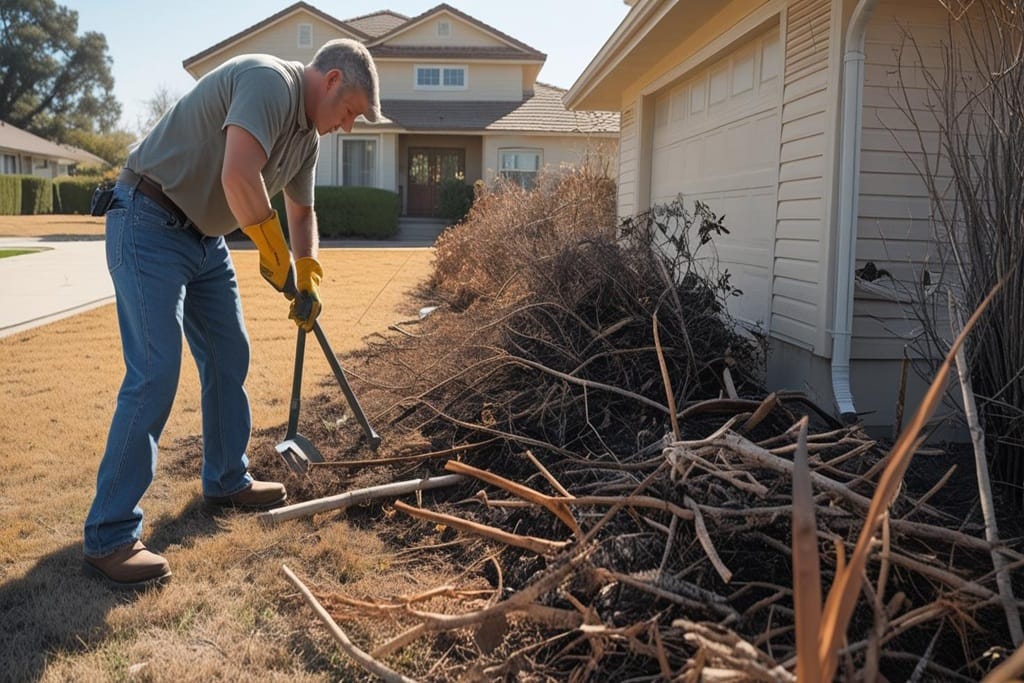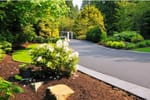Wildfires are becoming increasingly common, threatening homes and lives in their destructive path.
One critical way to safeguard your property from these disasters is by creating a defensible space around your home.
Defensible space not only helps protect your property but also makes it safer and easier for firefighters to do their job.
We will cover ten evidence-backed tips to help you build a defensible space around your home, ensuring that it withstands the threat of wildfires.
What Is Defensible Space?
Defensible space refers to the area around a home or structure that has been carefully managed to reduce fire hazards.
This well-maintained zone acts as a buffer between your home and the surrounding vegetation, making it harder for wildfires to spread and reducing the risk of property damage.
Fire professionals typically divide defensible space into three zones:
- Immediate Zone (0–5 feet from your home)
- Intermediate Zone (5–30 feet from your home)
- Extended Zone (30–100 feet from your home, depending on property size)
Each zone has specific strategies to limit the potential for fire to ignite your property.
Why Create A Defensible Space?
Growing evidence shows that homes with properly managed defensible space are significantly more likely to survive wildfires.
The National Fire Protection Association (NFPA) emphasizes that defensible space reduces the speed and intensity of fires, giving firefighting efforts a critical edge.
Creating and maintaining a defensible space is not only a smart precaution; in some areas, it’s legally required to reduce risks to your property and the community.
1)) Start With The Immediate Zone (0–5 Feet)
The area directly next to your home is the most crucial for fire protection.
- Keep it clear: Remove all flammable materials like dead leaves, dry grass, mulch, and pine needles from this zone.
- Non-combustible landscaping: Focus on using materials like gravel and hardscaping instead of plants.
- Don’t neglect vents and gutters: Clean gutters regularly to prevent the accumulation of flammable debris.
2)) Trim Overhanging Tree Branches
Overhanging tree branches act as fire ladders, enabling flames to reach your roof or windows.
- Trim tree limbs so they’re at least 10 feet away from your roof and walls.
- Remove tree branches within 6–10 feet above the ground to prevent fire from traveling upward through the understory.
3)) Space Out Shrubs And Vegetation (5–30 Feet)
Within the intermediate zone, plant spacing is critical for reducing fire spread.
- Keep a minimum of 5 feet between shrubs and bushes.
- Maintain a low-height clearance for shrubs near larger trees.
- Use fire-resistant plants like lavender, sage, and ornamental grasses.
Pro-Tip: Avoid planting directly under trees or overhanging structures.
4)) Create Breaks With Fire-Resistant Barriers
Hardscaping features can act as fire breaks and protect your home.
- Build gravel paths, stone walls, or fences to halt the advance of fire.
- Incorporate patios or driveways strategically to form additional barriers.
5)) Protect Windows And Doors
Glass windows and doors are vulnerable to heat and flames during wildfires.
- Install dual-paned, tempered glass windows, which provide greater fire resistance.
- Use non-flammable coverings, such as metal shutters, to safeguard windows and sliding glass doors.
- Ensure all gaps around windows and doors are sealed to block stray burning materials.
6)) Opt For Fire-Resistant Roofing And Sidings
Roofing materials often dictate a home's vulnerability to wildfires.
- Select Class A-rated roofing materials like metal, tile, or concrete shingles.
- Replace wooden or vinyl siding with fiber cement, stucco, or brick to improve fire resistance.
7)) Maintain Your Yard Regularly (30–100 Feet)
Reducing fire hazards in the extended zone ensures that flames lose intensity before they reach your home.
- Mow grass to under 4 inches in height.
- Clear dead vegetation and fallen leaves annually, especially before wildfire season.
- Create vertical and horizontal breaks between trees and shrubs.
8)) Install Spark Arresters
Sparks from chimneys can ignite surrounding structures and vegetation.
- Install a spark arrester at the top of your chimney to trap burning debris before it escapes.
- Ensure the mesh openings on the spark arrester comply with local fire codes.
9)) Keep Combustible Items Away From Structures
Items like patio furniture, barbecue grills, and stacked firewood pose fire risks when left near your home.
- Store firewood piles at least 30 feet away from your house.
- Use covers made from fire-resistant materials for outdoor equipment.
10)) Educate Your Family And Neighbors
Wildfire safety begins with awareness and community efforts.
- Work with your neighbors to create a collective defensible space.
- Regularly review and update your family’s evacuation plan.
- Join neighborhood wildfire preparedness programs to stay informed about local risks.
Shortlist Of Tools Used To Create Defensible Space:
- Lawn Mower: To maintain short grass and reduce flammable vegetation.
- Brush Cutter: Effective for clearing dense brush and heavy vegetation around the property.
- Chainsaw: Useful for trimming trees and removing any dead or overhanging branches.
- Rake and Leaf Blower: For clearing leaves, debris, and any combustible materials from the landscape.
- Garden Hose with Nozzle: Important for watering defensible zones and wetting down areas during high fire risk times.
- Drip Irrigation System: To keep landscaping hydrated, particularly in defensible zones
- Fire Resistant Mulch: To use around landscaping to help slow the spread of fire.
- Property Boundary Markers: To clearly define defensible space zones.
- Pruning Shears: For maintaining shrubs and trees to keep them healthy and fire-resistant.
- Fire Pit and Spark Screen: Safe outdoor options for fire use that minimize fire risk.
- Fire Extinguisher: Essential for quickly addressing any small fires before they escalate.
- Chipper/Shredder: For processing yard waste into mulch, reducing fuel loads around the home.
- Barrier Tools: Such as shovels and hoes, for creating firebreaks around the property.
Conclusion
Building defensible space isn’t a one-and-done task. It requires regular maintenance to stay effective.
Dedicate time each season to inspect your property for overgrowth or debris.
Check for updates to local fire regulations to ensure compliance.
By implementing these 10 proven tips, you’ll drastically improve your home's resilience against wildfires while creating peace of mind for you and your family.
If you’re ready to go a step further, reach out to your local fire department or garden center for professional advice on fireproof landscaping and building upgrades.
Download Our Free E-book!







